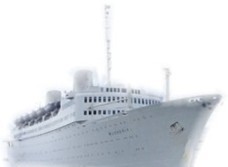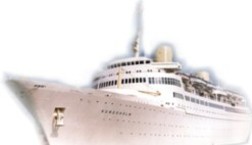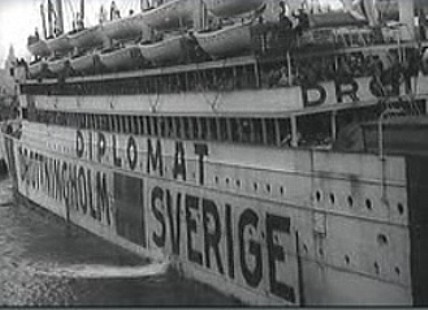 | 
|
|  | |||||
A Tribute to the Swedish American Line | ||||||||
| . | ||||||||
| . | ||||||||
| . | ||||||||
Stuart and George MacRitchie have kindly offered to share this excerpt of their father's memoirs.
Alistair Crawford Cameron MacRitchie was repatriated via Gothenburg after 3 1/2 years as a POW in
Poland,
after capture at St Valery on 12 June 1940 with the BEF. He spent two days on the Drottningholm
prior to transfer to a troop ship for the voyage home from Gothenborg in late 1943.
Stuart MacRitchie has also sent us a link to documents from his father's voyage.
BEF stands for British Expeditionary Force - the name given to the British forces sent to
France at the outbreak of war in 1939. RAMC stands for Royal Army Medical Corps -
Mr MacRitchie served in the RAMC as a medical orderly.

|
On board the Drottningholm in Gothenburg in 1943 On my arrival at the fort in Thorn my name and number were checked off on a sheet and I passed inside where, to my delight, my two friends of the early days met me. Excited questions followed and I realised that there was something in what the guard had said about me going home. Repatriation was on everyones lips. That night and early the next day our kit was whittled down to a bare minimum. Anything incriminating, photos etc. were destroyed for the most part. We gave our surplus to those lads who were not on the Repat party or the UK party as it was called. Then we formed up and marched out only to be halted for a search. It was perfunctory and a lot of us could have kicked ourselves for destroying interesting souvenirs, but it was the safest way. No one wanted to spoil the chances of getting away for good! Then aboard cattle trucks, still with guards. We travelled for at least 22 hours. Passing Stettin gave us a clue as to where we were going, for as yet, no one really and truly believed that repatriation was definite. We didn't trust the Gerry. Then en route a German officer worked along the trucks giving us receipts for money we had luing to our credit in the form of camp money in the Stalag. This sounded more definite. Then the train stopped and we were allowed out to see the Baltic shore a few yards away. It was good to see the sea again after so long and in such different circumstances to the 12 th June 1940 . Then across to the Island of Rugen – then we knew, our guards left us – we were free!! Aboard train ferries and over to Trelleborg in Sweden . We had a riotous reception and before we boarded electric trains for Gothenborg, scenes of merriment went on up and down the platforms. A crowd of Swedish Red Cross nurses and civilians were there to give us food . Some among us had accordions and there was one set of bagpipes at least and that station rung to the sounds of rousing Scots reels and strathspeys! I don't know if the nurses were picked – but if they are representative of the womenfolk, then they are a fine looking race! The greatest novelty to us were the sparkling brilliant lights. No blackout there! The train was very comfortable and furnished in an almost luxurious manner. The windows were wonderfully wide and gave a clear and uninterrupted view. Our journey began about 8 pm. Trains left at intervals of about 15 minutes. Our passing brought crowds to doors and windows and in isolated areas there would be a solitary person waving a sheet or some such article. We slept most of the way – it was an 8 hour run. In the early morning we ran on to a quay alongside the Drottningholm, a ship of the Swedish American Line. Everything went like clockwork. Everyone allocated to cabins for 2, 3 or 4 and as soon as we settled in, breakfast was announced – the dining salon and in fact the whole ship was run exactly the same as in pre war days with her full compliment of stewards etc. I'm sure many of us broke little laws of table etiquette by fingering the snow white napkins, the gleaming glasses and silver! It was too good to be true – no one to yell at you, to watch your every movement, no more the hated “los!” and “Arbeit!”. No more the insufficient food, the lousy quarters. It was all over bar the shouting! We were a day or two aboard this vessel glorying in our new found freedom. Bands were sent down to the quayside to play for us and generally we were made very much at ease. The Crown Princess came aboard and moved amongst us. Then on arrival of the British ships with the exchanged Germans, most of us were transferred to the trooper. Our convoy consisted of a troopship, a hospital ship and the Swedish liner. Lit from stem to stern they must have been an odd spectacle on war darkened seas! We left the Swedish harbour to the strains of both our national anthems and set course for home. Guided through the Skaggerak, then into the North Sea with only water between us and Britain. A few days more and we were within our own territorial waters. Then Leith and the pipe band to welcome us. We were home! |
Back to the Exchange and Repatriation Page
Back to the Drottningholm Page
More than 250 web pages developed and maintained by Lars Hemingstam ©1998-2023
Hasse Gustafsson and Tommy Stark have interviewed crew members and contributed many of the stories.
Email us
This site does not use cookies, nor do we save visitors' IP-addresses. We do not send information to any third party. If you find information or a photo about yourself, or a relative, and want do delete it, please email salship@yahoo.com, and the information or photo will be removed. (The General Data Protection Regulation (GDPR) does not apply to deceased persons.) Denna webbsajt andvänder inte cookies, vi sparar inte heller besökarnas IP-adresser. Vi skickar ingen information till tredje part. Om du finner information eller ett foto om dig, eller en släkting, och vill ta bort det, skriv till salship@yahoo.com så tar vi bort informationen eller fotografiet. (EU-regeln GDPR omfattar inte avlidna personer.) |
The New SAL Guestbook
|
